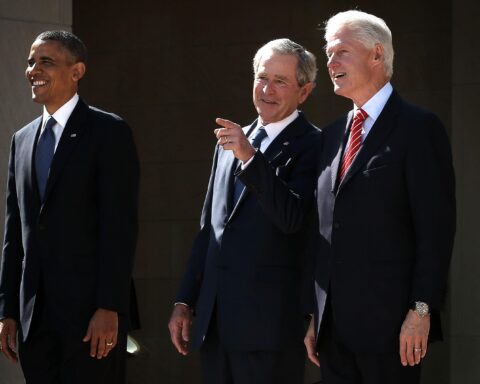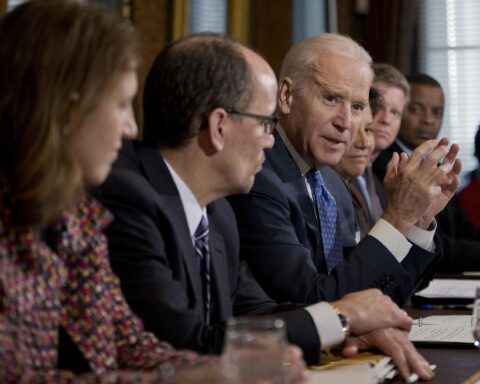With some wind in his sails from the massively popular Covid relief package, President Joe Biden’s next big legislative push — a sweeping infrastructure plan — is set to bring a far more challenging bipartisan test in the coming weeks.
The “Build Back Better” infrastructure proposal that White House aides are putting together would be segmented into two separate parts — one focused on infrastructure and clean energy, and a second focused on what’s being termed the “care economy” with a focus zeroed in on key domestic economic issues.
In full, it would mark a sweeping move toward enacting the key elements of the “jobs” agenda that Biden laid out in large part during his campaign for president, with a suite of potential tax increases on corporations and the wealthy as options to finance any longer-term spending in the final proposal.
That’s where things get tricky.
As CNN’s John Harwood writes, the plan contains some fat political targets. Republicans deride as “welfare” some of the tax credits it directs to help families climb the economic ladder.
They skewer alternative energy investments and regulations to combat climate change as costly and radical.
As Senate GOP Leader Mitch McConnell summarized it: “A so-called infrastructure proposal that may actually be a Trojan horse for massive tax hikes and other job-killing left-wing policies.”
But Biden is determined to find Republican support. The President plans to pursue bipartisan support, according to his advisers. He’s already held multiple bipartisan Oval Office meetings on the issue. During a meeting with labor leaders in February, Biden repeatedly stressed that he thought there was a path for bipartisanship on the issue, according to an attendee.
There’s still a backup plan. Officials are also planning for congressional Democrats to move concurrently with a budget procedurethat would allow any package to pass with a simple majority in the US Senate.
The nuts and bolts. The infrastructure proposal would focus heavily on money for roads, bridges and rails, and would include hundreds of billions in spending for climate-related measures, as well as climate-related research and development. It also would include $100 billion for education infrastructure.
The domestic economy piece of the plan would include key Biden campaign priorities such as universal pre-K, significant spending on childcare, care-giving and proposals designed to try and address portions of the workforce hit hardest by the pandemic economy.
The debate will kick off in earnest soon. While the planning remains fluid, officials are tentatively eyeing Biden’s joint address to Congress — likely to be scheduled in April — as a moment where the key thematic elements of the package are made clear.
More on Georgia’s election law
How SCOTUS laid the path for Georgia’s election law. The voter restrictions were dashed into law by Republicans shaken over recent election losses and lies about fraud from former President Donald Trump, yet the measures also developed against a backdrop of US Supreme Court decisions hollowing out federal voting rights protection.
Biden calls it ‘Jim Crow in the 21st century.’ The President labeled the election law “Jim Crow in the 21st century” and “an atrocity,” saying the Justice Department is “taking a look” at the measure.
‘We’ve got to work on the infrastructure of our democracy’ Democratic Georgia Sen. Ralph Warnock told CNN’s Dana Bash on “State of the Union” that everyone has a decision to make: “Are we going to stand on the side of truth and righteousness and justice? Are we going to stand up on the right side of history? This is a defining moment in the American nation and all of us have a role to play.”
Attorney for arrested Georgia state representative speaks out. An attorney for Georgia state Rep. Park Cannon vowed that the Democrat will contest the charges she faces after being arrested Thursday for knocking on Georgia Gov. Brian Kemp’s office door while he signed a sweeping elections bill into law.
Will this backfire on Georgia Republicans? CNN’s John Blake writes that the election law may prove to be a clumsy political miscalculation.
There’s growing evidence to suggest that voter restriction laws sometimes backfire against their proponents.
By attacking voting rights Georgia Republicans have abandoned a GOP political strategy that helped them win close elections. And they have angered a powerful bloc of Black voters in Georgia who have already mobilized against them.
Preparing for a long border crisis
The crisis at the US-Mexico border isn’t going to subside anytime soon.
While the Biden administration begins to get a handle on the coronavirus pandemic, internal government estimates obtained by CNN’s Priscilla Alvarez underscore a border crisis still in its infancy:
- At least 34,100 additional beds could be needed to keep up with the projected number of unaccompanied kids arriving at the US-Mexico border through September, the internal government estimates project.
- At least 158,000 unaccompanied children could arrive at the Southern border from April through September.
- Nearly 5,500 unaccompanied migrant children were in Customs and Border Protection facilities as of Thursday, housing that is akin to jail-like conditions.
- More than 12,550 children were in the custody of the Department of Health and Human Services, which is charged with the care of migrant children.
- Around 90 hours is the average time children are spending in Border Patrol custody, a senior Border Patrol official said. But there are times when it is upward of 100 hours — longer than the 72-hour legal limit.
Remember, border arrivals typically rise in the spring, but the Covid-19 pandemic has exacerbated the situation and further limited the capacity along the border to process migrants.
To compare, in May 2019, at the height of that crisis, 11,475 unaccompanied kids were arrested by US Border Patrol. In June 2014, during the peak surge of children at the border, 10,620 unaccompanied children were arrested by US Border Patrol.
There are several factors at play this time, including deteriorating conditions in Latin America, pent-up demand to enter the US and a perceived relaxation of enforcement under Biden that are driving migrants to the border at what appears to be an accelerated pace.
Pandemic snapshot
As we mentioned last week, the US doesn’t have to just accept another surge in coronavirus cases.
The medical cavalry is here and rolling out fast. But the combination of relaxed mitigation measures, increased travel, and a dangerous variant is proving to be a formidable challenge.
Put simply, the race between vaccines and variants is a close one.
Take it from CDC Director Dr. Rochelle Walensky who described this perilous moment in the pandemic at the White House last week:
- “We know from prior surges that if we don’t control things now, there is a real potential for the epidemic curve to soar again.”
- “Please,” she said, “take this moment very seriously.”
- “I know people are tired,” Walensky continued. “We’re just asking people to hang on a little while longer in terms of the masks and the mitigation strategies so that we can get the majority of people vaccinated.”
Where are we are vaccinations? So far roughly 15.5% of the US population is fully vaccinated as of Sunday evening — meaning not enough Americans are yet protected to suppress the spread of the virus through herd immunity.
But soon, supply won’t be the issue. Some experts fear that the upcoming challenge won’t be a short supply of vaccine — but getting enough people vaccinated.
“We have a lot of vaccine, we’ll have more over the next month,” Dr. Jonathan Reiner, a professor of medicine at George Washington University, told CNN on Saturday. “The challenge is to get the shots into arms and then to convince the hesitant to get the shots.”
B.1.1.7 is spreading fast. So far, the CDC has reported more than 8,300 cases of the variant in the US — and the agency has previously said the number only represents cases that have been found with the help of genetic sequencing.
Keep these links handy. CNN is tracking vaccine distribution in the US and in countries across the globe.
The bottom line is still the same. What can help fight another Covid-19 surge, according to experts, are the measures that have been proven to work: face masks, social distancing, avoiding crowds, and regularly washing hands.
‘COVID WAR: The Pandemic Doctors Speak Out’
CNN Chief Medical Correspondent Dr. Sanjay Gupta asked six of the doctors who have run point on the pandemic response to provide their insights on what the US could have done differently in the new documentary, “COVID WAR: The Pandemic Doctors Speak Out,” which airs Sunday at 9 p.m. ET on CNN.
In the documentary, Birx gives Gupta her gut-wrenching answer when asked how much of an impact it would have made if the US had paused earlier and followed through with the safety measures that were proven to slow the spread.
“I look at it this way. The first time we have an excuse,” Birx says. “There were about a hundred thousand deaths that came from that original surge. All of the rest of them, in my mind, could have been mitigated or decreased substantially.”
Watch Sunday evening at 9 p.m. ET on CNN or stream on CNNgo.
‘Manifestly false’
That’s how Mick Mulvaney, Trump’s former chief of staff, characterized his former boss’ recent attempt to whitewash the history of the January 6 Capitol riot.
Mulvaney, who stepped down as Trump’s special envoy to Northern Ireland after the insurrection, offered a pointed rebuke to Trump’s comments that his supporters were “hugging and kissing” police officers and posed “zero threat,” despite widespread violence.
“I was surprised to hear the President say that. Clearly there were people who were behaving themselves, and then there were people who absolutely were not, but to come out and say that everyone was fine and there was no risk, that’s just manifestly false — people died, other people were severely injured,” Mulvaney told CNN’s Pamela Brown on “Newsroom.”





